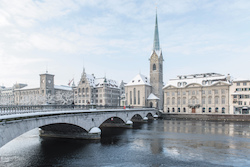Speaker
Dr
Odile Crabeck
(University of manitoba)
Description
Past and recent literature have highlighted that sea ice might play a crucial role in controlling and contributing to the exchange of significant climatically active biogases between the ocean and the atmosphere in polar areas. However, the formation of air inclusions and the transport of gases within sea ice cover are still poorly understood. In it is pure form sea ice is a multi-phase system formed by the freezing of seawater, which consists of ice, salt precipitates, liquid brine, and air bubble (WMO, 1970). As the ice growth under cooling condition, each brine inclusion shrinks in size until the internal salinity of the inclusion is high enough to compensate further cooling. In these smallest inclusions, the concentration of salts as well as others solutes (e.g. gases, dissolved inorganic carbon) can increase to a point where the solution is supersaturated (concentration effect). Conversely, if the temperature of the ice cover increases under warming conditions, some of the pure ice along the inclusion walls melts, expanding the brine inclusions and diluting the brine, which lowers the brine salinity. Gases are incorporated in dissolved phase in the brine during ice growth and literature suggest that bubble nucleation further happened in supersaturated brine inclusions. Recent modelling study concluded that the partitioning between dissolved and gaseous phases can play a critical role in gas transport in sea ice, since the transport of gas in air bubble might be decoupled from brine motion. Since there is no analytical method to assess the partitioning of gases between dissolved and gaseous forms in brine, the brine saturation state is commonly used as proxy to estimate the fraction of gas residing in bubble. According to the reasoning therein, bubble formation should increase as temperature decreases due the concentration effect in winter (cooling). However recent experiences using both traditional (crushing and gas chromatography) and new sea ice analytical techniques (CT-Imaging and Raman spectrometry) show that nucleation is not a linear function of the saturation state and that bubble may shrink in size or disappear during cooling. Our results suggest that surface tension and brine internal pressure might control gas nucleation processes in brine. Results from this work are a valuable addition to limited studies available on gas content dynamics in sea ice, and provides new methodology for the interpretation and characterization of sea ice porosity as well as new knowledge for sea ice modelling.
Significance statement
The findings of this research contribute to the field of sea ice physics as they provide new suitable techniques to characterize air bubble and new discussions on processes controlling sea ice gas content and transport .
Author
Dr
Odile Crabeck
(University of manitoba)
Co-authors
Prof.
Bruno Delille
(University de Liege)
Prof.
Jean-Louis Tison
(University Libre de Bruxelles)
Dr
Ryan Galley
(University Of Manitoba)
Prof.
Soren Rysgaard
(University of Manitoba)

